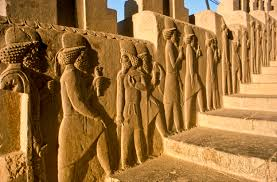When we think of the Persian Empire, names like Xerxes and Darius often spring to mind. These towering figures undoubtedly shaped history, but the Persian Empire was far more than just a tale of kings and battles. It was a civilization teeming with innovation, culture, and complexity that left an indelible mark on the world. Let’s journey beyond the well-known narratives and dive into the fascinating depths of this ancient powerhouse.
A Glimpse Into the Beginnings

Who Were the Persians?
The Persians originated as an Indo-European people who settled in the Iranian plateau around 1500 BCE. They were initially a collection of tribes, but under the leadership of figures like Cyrus the Great, they unified and established one of the world’s most influential empires.
The Rise of the Achaemenid Dynasty
Cyrus the Great (r. 559–530 BCE) founded the Achaemenid Empire, which would grow to become the largest empire the world had ever seen. His conquests were marked by a unique approach to governance: he respected the customs and religions of the lands he conquered, setting a precedent for multicultural administration.
The mRNA Revolution: How a Lab Accident Changed Medicine Forever
Beyond Xerxes and Darius: The Unsung Leaders
Cambyses II: The Forgotten Pharaoh
Often overshadowed by his father Cyrus, Cambyses II expanded the empire into Egypt, becoming a pharaoh. His reign, though significant, is frequently misrepresented in historical texts as tyrannical due to Greek biases.
Artaxerxes I and the Flowering of Persian Culture
Artaxerxes I (r. 465–424 BCE) presided over a period of cultural flourishing. He supported the arts, architecture, and the Zoroastrian religion, which played a central role in Persian identity.
Innovations That Shaped the World
The Royal Road: A Network of Connectivity
The Persian Empire was ahead of its time in infrastructure. The Royal Road, stretching over 1,500 miles, connected key cities and enabled efficient communication and trade.
Postal System: An Ancient Innovation
Think mail is a modern invention? Think again. The Persians developed a sophisticated postal system using relay stations, ensuring swift delivery of messages across their vast empire.
qanats: Engineering Marvels
To combat arid conditions, Persians pioneered qanats, underground irrigation channels that transported water over long distances. This innovation sustained agriculture and urban centers in harsh climates.
A Tapestry of Cultures
Embracing Diversity
Unlike many empires, the Persians didn’t impose their culture on conquered peoples. Instead, they allowed local traditions to thrive, creating a melting pot of cultures within their borders.
Zoroastrianism: The Spiritual Backbone
Zoroastrianism, the empire’s dominant religion, emphasized principles of good and evil, influencing later religions like Judaism, Christianity, and Islam.
Military Prowess Beyond the Stereotypes
Immortals: The Elite Guard
The Persian Immortals were an elite force of 10,000 soldiers, renowned for their discipline and skill. Their presence symbolized the strength and continuity of the empire.
Strategy Over Brutality
Persian military campaigns often relied on strategic alliances and psychological tactics rather than sheer force, demonstrating a nuanced approach to warfare.
Art and Architecture: A Legacy Etched in Stone
Persepolis: The Jewel of the Empire
Persepolis, the ceremonial capital, is a testament to Persian architectural brilliance. Its grand palaces and intricate reliefs showcase the empire’s artistic achievements.
Gardens: Paradise on Earth
The Persians were masters of landscape design. Their lush, symmetrical gardens, known as “pardis” (the origin of the word “paradise”), symbolized harmony and order.
Economy: The Engine of an Empire
Standardized Coinage
To facilitate trade, the Persians introduced standardized coinage, such as the gold daric, which became a benchmark for economic transactions across the empire.
Trade Networks
The Persian Empire’s strategic location bridged East and West, fostering trade of goods like spices, textiles, and precious metals.
The Decline: What Went Wrong?
Alexander the Great’s Conquests
While internal strife weakened the empire, it was Alexander the Great’s military campaigns that ultimately brought the Achaemenid Empire to its knees in 330 BCE.
Lessons in Overreach
The sheer size of the empire made governance challenging, highlighting the difficulties of managing vast, diverse territories.
Beyond the Achaemenids: The Parthians and Sasanians
The Parthian Empire
After Alexander’s death, the Parthians emerged, continuing Persian traditions and serving as a bridge between the Achaemenid and Sasanian empires.
The Sasanian Renaissance
The Sasanians (224–651 CE) revitalized Persian culture, leaving a lasting legacy in art, architecture, and governance that influenced the Islamic world.
The Persian Empire’s Global Impact
Influencing Governance
The Persian model of administration, with its satraps (provincial governors) and centralized bureaucracy, inspired later empires like Rome.
Cultural Exchanges
From Greek philosophers to Indian astronomers, the Persian Empire facilitated a cross-pollination of ideas that enriched human knowledge.
Conclusion
The Persian Empire was a beacon of innovation, culture, and governance that extended far beyond its famous rulers. By embracing diversity and pioneering advancements in infrastructure, administration, and art, it laid the foundation for many aspects of modern civilization. Exploring its rich history reveals a tapestry woven with threads of ingenuity and resilience, ensuring its legacy endures in the annals of human achievement.
FAQs
What Was the Official Language of the Persian Empire?
Old Persian was the official language, but Aramaic served as a lingua franca due to the empire’s vast and diverse population.
How Did the Persian Empire Treat Conquered Peoples?
The Persians were known for their tolerance, allowing conquered peoples to maintain their customs and religions.
What Role Did Women Play in Persian Society?
Women in Persia held significant roles, especially in the royal court, and some, like Queen Atossa, wielded considerable influence.
Was the Persian Empire Connected to the Silk Road?
Yes, the Persian Empire was a key player in the early Silk Road, facilitating trade between Asia and the Mediterranean.
How Long Did the Persian Empire Last?
The Achaemenid Empire lasted about 220 years (550–330 BCE), but Persian culture and influence endured through subsequent dynasties like the Parthians and Sasanians.


